Night Vision vs. Thermal Vision
What you can’t see CAN hurt you!
By: Devin S. Standard
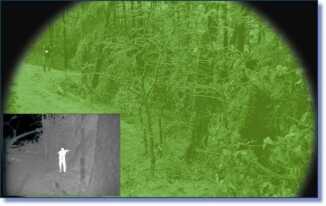 |
| An enemy target in both thermal and standard night vision. |
A crash in the night, your heart goes THUMP! We humans have an innate fear of darkness programmed into the firmware of our DNA. It isn’t imagined. What you can’t see in the dark CAN hurt you. The cover of darkness has been the friend of the predator, the criminal, the terrorist, the Devil Himself, which is why night vision manufacturing is now a billion-dollar business. Night vision technology has come a long way in the last ten years. Gradually the prices have come way down. What used to be available to just the military is now within the financial reach of civilians and law enforcement.
I recently had the opportunity to do some night operations training down in North Carolina. Wow! Whether running and gunning with, helmet-mounted goggles, engaging targets with a night vision scope, or sending .308 projectiles down-range with the aid of a thermal scope, the ability to see in the dark delivers a super-human like feeling of invincibility! Hundreds of thousands of night vision devices are giving our fighting forces a significant advantage on foreign battlefields this very evening. Tens of thousands of law enforcement professionals are currently using night vision to help keep the streets safe. You need to get some of this technology too, and now you can.
- Night vision generally works in 3 different ways:
- Image Intensification (I2) – This is the most common type of night vision technology. It works, in the darkness, by capturing the tiny amount of available ambient light coming from the moon, stars and artificial sources. I2 also captures the lower end of the infrared light spectrum, that type of light is usually imperceptible to our eyes, but is present. The device captures these light sources, amplifies them thousands of times via an electronic “tube”, and projects the image on a viewing lens. The images appear a grey green color and there is a nice level of detail rendered with the latest, GEN III and GEN IV technology. You can even see through windows with I2. Note: There must be some light, I2 will not work in total darkness, such as in caves.
- Thermal imaging – Thermal technology operates not by aggregating light; but by capturing the “heat” emitted by all object/persons. This “heat”, is literally the upper portion of the infrared light spectrum. Hot objects, like running machines, people and animals, emit more of this “light”/”heat” than cooler objects like rocks, trees or buildings. The image appear in gray-white or gray-black depending upon your preference, as the polarity can be adjusted so heat can either be shown black, or white. The thermal images are crisp enough to clearly distinguish facial features within 25-30 meters. Thermal imagers are commonly called thermal cameras, thermal sights, thermal monoculars or thermal binoculars. Note: Thermal imaging technology does not allow you to see through windows, or under water, because the “heat” is reflected back. In fact, you will see your body heated reflected back off the surface.
- Fusion– Thermal imaging and Image Intensification (I2) technology have now been combined in single devices so both the infrared energy and the ambient light are captured. This allows the operator to now identify people and objects in almost all low-light/no-light environments. Now, thanks to fusion technology, Osama can’t hide in the total darkness of a cave, we can see him through windows, fog, etc. Fusion can be operated as an (I2) device, as a thermal imager, or in a combination mode. I recently got to try a $50,000 Fusion Goggle and I have to say,”wow, you can see someone’s soul”! There is even a mode in which there is an electric green wire frame outlining people. This is a great aid in targeting. You are the Predator! Sorry I cannot show you a fusion image.
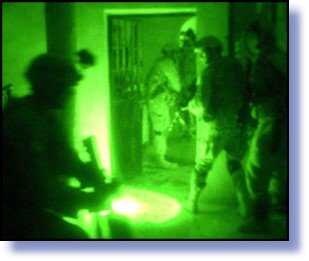 |
| Night vision operation. |
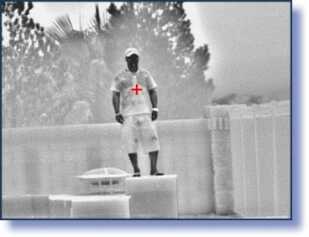 |
| Thermal image. |
These three technologies are regulated under International Trafficking in Arms Regulations (ITAR). This means, as a non-felonious US Citizen, you should be able to purchase them; but you may not export them. “Exporting” includes demonstrating them to non-US persons, agents or firms, as well as not leaving US waters upon your boat. There may be exceptions. Check with your legal counsel. Thank God, I am not a lawyer.
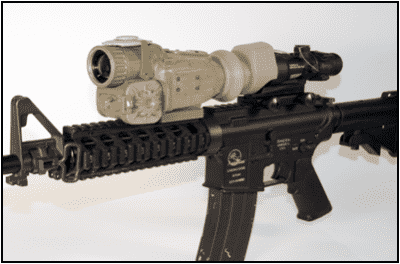 |
| Weapon mounted thermal. |
IMPORTANT ACRONYMS:
- NVD– Night vision device
- NVM– Night vision monocle
- NVG– Night vision goggle
- I2– Image intensification
- MCP– Micro-channel plate
- IR– Infrared
- FPA– Focal plane array
Now that you’ve decided you want to negate the night, it’s time to decide what to buy. First of all let’s look at I2 products. They come in several different generations: GEN 0, GEN I, GEN II, GEN III and GEN IV. As with ammunition’s +P and +P+ varieties, there are some additional identifiers with night vision devices. I am going to forego those details until a future column.
Devices also come with names like PVS-7, A/NPVS-14, etc. Those are simply US military logistical codes for identifying various products. The A/N stands for Army/Navy and the PVS stands for Passive Vision Site. The most common one you will see on today’s battlefields in the AN/PVS-14, or PVS-14, which is a GEN III night vision monocle which can be hand held, weapon, or helmet mountable,
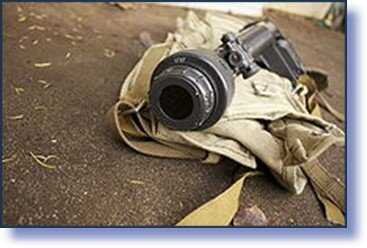 |
| Soviet era nightvision. |
GEN 0: They were developed by AEG for the German army in the late 1930’s and several other firms for the US during the same time period. These early devices used large infrared illuminators to highlight the targets and a “tube” consisting of an anode and photocathode to create the image. The resolution was not great. You wouldn’t want to pay for one of these, except for potential collectability.
GEN I devices became available during the Vietnam War era. They were essentially GEN 0 with technology enhancements, allowing the utilization ambient light instead of artificial infrared light. The light is amplified by about 1,000 times by a GEN I NVD. The technology improvements have made them significantly smaller and lighter than GEN 0; but their 1960’s photocathode based image intensifiers were still large and expensive, and required bright starlight or moon light in order to function well. You most likely have heard the term “Starlight Scope”, and starlight was, and is, key to the functionality of GEN I night vision devices.
 |
| Vietnam era nightvision. |
There have been steady refinements in miniaturization, optics and ruggedness of these devices. Now you can buy a fairly decent Gen I night vision device for less than $250. With it, you should be able to observe targets, with pretty good clarity, out to about 75 Yards. There will be a small amount of electronic whining when a GEN I device is on. Additionally, there will usually be a bit of distortion along the periphery of the image, and the eyepiece will momentarily keep glowing after shutting it down, similar to an old fashioned TV. Overall, a pretty good, cost effective solution for home defense for those on a really tight budget.
GENII devices are widely used by law enforcement and professional operators. They are even more robust than GEN I NDVs. GEN IIs are further enhanced by the inclusion of an MCP, or Micro-channel Plate and an even better photocathode tube, and S-25. The MCP goes directly in front of the photo cathode and acts as an electron amplifier. The thousands of additional
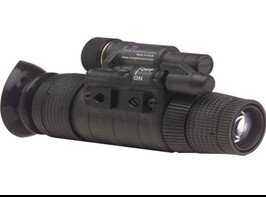 |
| Gen II NV Monocular, Hand Held, Helmet or Weapon Mountable. $2899 Retail |
electrons, released by the MCP, deliver the user a much brighter and crisper image, particularly around the edges. The light is amplified by about 20,000 times. Also, the effective range of the GEN II is increased to about 100 yards in pitch black conditions, a 33% enhancement over GEN I units. Caution: these can be damaged by pointing directly at bright lights. GEN II devices typically cost $500-1000 more than a GEN I NVD. GEN II night vision is a solid solution for the responsible homeowner and law enforcement officer.
GEN III NVDs are the good stuff in terms of night vision tools. Costing about $3000 and up, they have been improved by further advances in material science. Significant additional enhancements have been made in their electronic guts. The Photocathode has been made with Gallium Arsenide and the GEN II Micro-channel Plate (MCP) has been updated by coating it with a highly precise ion barrier. This combination results in an even brighter and crisper image than was possible with GEN II. The light amplification is also improved to around 30,000-50,000 . An operator using a GEN III device will enjoy being able to identify and monitor activities at 150 yards or more in nearly pitch black conditions. There is only one minor shortcoming I’ve found when evaluating GEN III NVDs. I noticed a bit of a green halo when looking at, or around, very bright objects (street lights). This minor green halo might cause the observer to miss some of fine detail at distance, such as if a subject is holding a small gun or knife, when the subject is standing in front of a light source. Every cop or soldier knows these items are
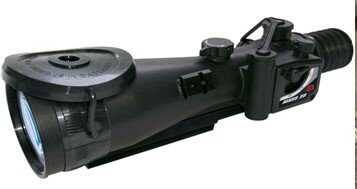 |
| Gen III NV Rifle Scope. $3,000 Retail |
difficult to detect as a distance in bright daylight, so caution is always recommended when dealing with potential threats. If you can afford $3-4,000, GEN IV is a technology choice for both home-defense, and professional high-speed, low-drag operators. (I fantasize about have a master power switch in my bedroom and putting on my goggles! (yes I know I’m not supposed to clear the house alone)
GEN IV gets complicated. There is currently no agreement among the military, law enforcement and the manufacturers on what to call these excellent devices. They are known by any of the following names:
- Omnibus-VII
- GEN III+
- GEN IV
- Filmless & Gated I2
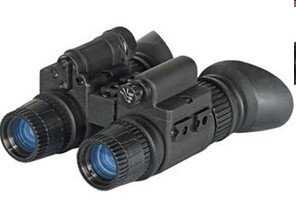 |
| Gen IV NV Binoculars $8000 Retail |
Let’s call them GEN IV for our purposes. GEN IV NVDs are state of the art. These offer excellent viewing up to 1,000 yards under the right conditions due, in part, to GEN IV’s new gated, filmless technology. Another significant enhancement is the installation of an automatic gated power supply. This development precisely and quickly regulates the photocathode voltage, allowing the NVD to instantaneously adapt to changing light conditions. Meaning it rapidly adjusts as you move among conditions with differing levels of light.
Another change is that the ion barrier film has actually been removed from the system, allowing significant increases in target identification at longer ranges, and, under very low light conditions. The signal to noise ratio is significantly increased as a result of the optimized filmless MCP, this yields better image quality in extremely low light conditions. What that means is that a significantly higher percentage of electrons are properly harnessed into image creation as opposed to “noise”, or pixilated distractions from the image. The contrast adjustments are better too, making the device perform better under all light conditions. Even the previously discussed “halo” is almost non-existent. The downside to removing the ion barrier means a diminished device life expectancy, from 20,000 hours to 15,000 hours mean time between failures. This equates to a reduction in mean life expectancy from 1666 nights service life to 1250 nights. Most manufacturers give a solid 2 year warranty, so I am not overly concerned. I really hope I won’t be tasked with over 1,000 night missions. If I am, someone else is paying for my NVD.
How good are these? Some SWAT guys and I recently evaluated a unit in Wyoming. We had no problem identifying subjects at 600 yards, typically an effective range for .223. I’d say on ops with a .338 Lapua, .308 or .300WinMag, you could project your will to the 1,000 yard range, under the right conditions, without the subject even knowing you were in the vicinity. A Gen IV NVD is on my Christmas list. Hopefully my wife will win the lottery.
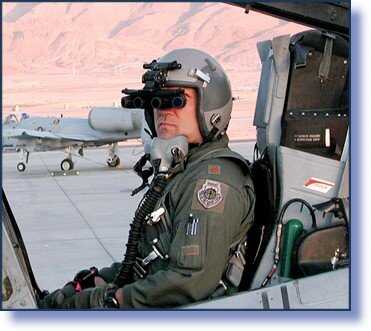 |
| Panoramic NV Goggles Priceless |
THERMAL
Thermal night vision devices rock. The prices are coming down quickly; but they are still really expensive, $5,000 and up for a good hand held and $11,000 and up for weapon mountable versions. As I was recently in the employ of a defense contractor, I had the opportunity to send a fair bit of lead downrange, targeted with by a variety of thermal weapon sites. I also got paid to extensively evaluate several hand-held thermal imaging models. For the purpose of this article, I am going to ignore vehicle and aircraft systems and focus entirely on man portable systems, those with which I have experience.
All living things generate their own heat and will produce a signature, while inanimate objects will absorb solar radiation as well as heat from artificial sources, and produce a thermal signature. Thermal imaging works by capturing the infrared energy that is reflected by all bodies containing heat, passing it through a thermal core (microbolometer) onto a Focal Plane Array (FPA) via an advanced image processing algorithm. Just as with computers and cameras, they are rapidly getting smaller and more powerful. The better devices are extremely sensitive, and currently able to detect differences as small as .01 degrees Centigrade. This means you can see the residual heat left when someone has touched a wall or walked across your carpet until the heat dissipates, wow. You can see video of this on Youtube.com. Here is a good example: https://www.youtube.com/watch?v=d4vZKGq3lE8. Just type in “thermal image” if this linked film isn’t running for some reason. There is quite a collection of videos.
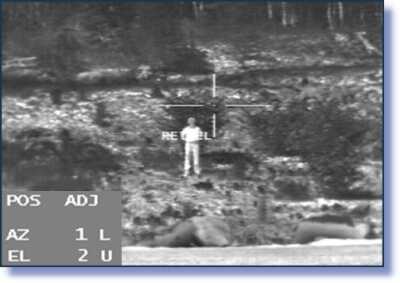 |
| The reticicle of a weapons mounted thermal. |
Thermal devices capture the heat information from all objects, including the ground, rocks, trees, etc., within its field of view. The device’s processor then creates an image for you to see. People and animals can’t hide their body heat, so users equipped with thermal devices can easily identify them, their foot, hand or paw prints, etc. Thermal imagers work the same during the day, or at night, so the tool can be used for target observation 24/7/365. Unlike the previously discussed night vision, which requires minimal light and an un-obscured line of sight, to the target, with thermal imagers, you can:
- See people in total/absolute darkness
- See people through smoke, dust, and light fog, light rain and light snow.
- See people through camouflage and foliage in any lighting conditions
- See more – and see farther – than with other low-light night vision goggles and cameras.
5 things distinguish thermal cameras from one another;
- Resolution is expressed as: 160 x 120, 320 240, and 640 x512. The higher the number, the larger the number of pixels/unit of area. The greater the number of pixels/area, the better the accuracy of temperature measurement yielding clearer, more precise pictures. The resolution race is on among various manufacturers, and crisper images are today’s standard as opposed to the “blob cams” of the 1990’s.
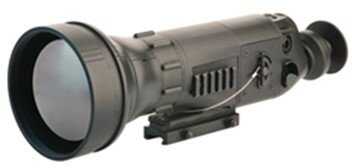
Thermal Weapon Site $15,000 - Refresh Rate, expressed in Hertz, is another way of saying frames/second as in movie film. The higher the better. A 50/60Hz devices will refresh at 50/60 frames/second and will give full motion video, just like watching TV. Slower refresh rates will exhibit some drag, and the images may be jumpy, or have some blurring if the user turns the device quickly. Only low refresh rate thermal imagers may be exported without going through the Department of State paperwork. Please be careful, we don’t want the good stuff in the wrong hands.
- The leading manufacturers now produce high performance thermal cameras with color images. The color does not match human visual reality; but small differences in temperature. Once you get used to the artificial color palette, this is proving ever more popular. It is nice for clearly distinguishing guns on a person’s body versus the more common grey scale, black & white displays.
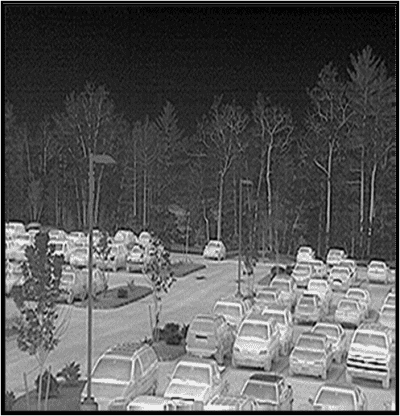
A parking lot with thermal vision - Ruggedness: Hand held Mil-spec thermal cameras are generally built to be waterproof to 66′, to withstand extreme changes in temperature and even multiple drops from 4′ onto concrete. Weapon-mountable, Mil-spec thermal sights are designed to stand up to weapon recoil as well.
- High-end thermal cameras also have the ability to measure target temperatures. This is called Thermography. This is a great tool for knowing whether a machine is running in an optimal operating temperature range, whether a suspect is sweating or feverish, etc. I’ve heard that road side bombs clearly have a different temperature/color than the dirt, debris or other material under which they are hidden. I have no personal experience with this however.
Both night vision and thermal imaging device come in a variety of form factors.
Configurations
NVD’s and thermal imagers come in various configurations:
- Monoculars – Helmet-mounted, Weapon mountable (typically mounts in front of day optic), and Hand held
- Dedicated rifle scope
- Binoculars
- Cameras
- Goggles
- Panoramic goggles
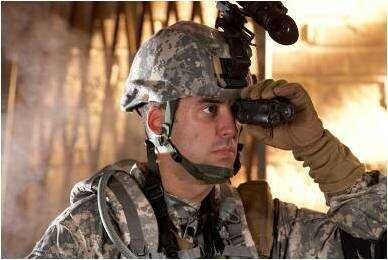 |
| A parking lot with thermal vision |
My recommendation for the non-military user is to buy a hand-held monocular unit which can be head-mounted, helmet-mounted or weapon-mounted. This way you have the flexibility to configure it in the manner most suitable for your mission requirement. For home defense, for example, helmet or head mounting makes a lot of sense. You hear the bump in the night, put it on and do what you have to do, without your Surefire giving away your position. Also, the head/helmet mounting means your hands will be free for other requirements. Additionally, I would look for a product from a reputable manufacturer such as Flir, Trijicon, ATN, Meprolight, or other, verifiable, military suppliers.
Good luck with the zombies.
About the Author: Devin S. Standard is an NRA pistol instructor, an accomplished martial artist, a hunter, a defense industry executive and a family man who has lived, worked and traveled extensively in Europe, Latin America, Asia and Africa. He has survived several disasters, one war, trekked Everest, ridden 4 bulls and crossed the Sahara on a motorcycle. He resides somewhere in the Live Free or Die State of New Hampshire.

Great to see comparison chart of night vision vs thermal vision device.
Thank you for sharing this useful information.
Rammy
DMA Inc.
I have a 1-4X24, FFP ILLUM. BTR RETICLE on a high rise mount on my ar-15 and I wanna try to find a way to mount a Bushnell NightVision 4.5×40 Equinox Z, Rifle Mount in front of it but idk how to make them line up. Any suggestions?
I have seen some of the best thermal imaging scoops sites and ptz tripod mount systems recently at a fair for law-enforcement and Homeland security, SPI Corp. Robotically designed a scope that I have never seen before it had like six sensors in it with the fusion and all sorts of Geo locating capabilities, hi band lasers – it was mind-boggling. This device I would be proud to say is the real US forces motto saying that they own the night.
Can anyone tell me if it’s OK to use monoculars on a 308? Or would the recoil mess it up? Thanks for any help!
Depends on what you have reply to me and let me know what you have and I will look it up for you. Cheers
I had a large 4.5 acre mostly wooded area, been having numerous tresspassers, and thieves, ANYWAY, throuhg the field grass and forrest canopy does thermal stil show through leaves and brush, or would GEN 3 NV be a better choice at ID’s the unknown person/s. they seem to also have NW some of them had IR illuminations that turn off when i send any IR LEDS Back. Also a strange Orange beam which must the a weapon sight, appears to scatter in a scan pattern, or possible optic refraction through moving foliage, very advanced, I also live next a small armory and adbandoned industrial park. so most likely they are doing some night drills. andmy property has poorly defined perimenter, any attempt to use voice communication is met with silence, sorry to into such depth, posting no tresspass signs should help. My basic question is will i be able to see any detail with Thermal through dense foiliage, would NV be even worse, I cant keep reporting strange activity until i have some VERIFIABLE evidence, and can have sheriffs and search dog, hopefully catching in the act. Neighbors all have had break-ins cut locks, and strange paths, sounds)(whistles)(fake animal calls) (Strange cb traffic). All flat terrian, do i need thermal, GEN 3 or higher. what would be your response in my situation, ALL neighbors and local police are on alert, but no moon plus very many escape routes doesnt make it easy. I dont want to get hurt, but I also need to know WHO WHY FRIEND OR FOE AND WHAT ARE THE INTENTIONS, Thanks for your help bascially does thermal see through even sparse vegetation, or does gen 3 help identify motion at longer range. Thanks
I have a unit that sits on a tripod. It will go out to 4 miles . It hooks up to a monitor and see thermo and ir . I am selling this for 10,000 if interested. It is made by Iraytek zs 303 it is in mint condition, it is awesome contact for more details
Nice article – re the ITAR topic – some manufacturers get around these restrictions, the European company Pyser-Sgi:
http://www.pyser-sgi.com/defence-security/night-day-vision-weapon-sights/iri2-detail
for example, sells a fusion sight “IRi2” that they classify as “NON ITAR, representing the latest in weapon sight fusion”
..
what is the best and most reasonable thermal imagine scope for a coyote hunter to buy. thanks for any help
Don’t know. They are slow sending us review scopes.
Any idea if there is a weapon sight that can be used with Thermal goggles, eg TG-7 Thermal Goggles
I gather if one had a laser sight that generated enough heat then it may be able to be seen through the thermal goggles? This would mean you could utilize thermal goggles in a combat situation and be able to fire using the ‘gun mounted laser’ without removing goggles…? The same effect as NVG and weapon mounted IR laser or normal laser.
nice article. i think night vision will slowly go down. seriously the potential of thermal imaging systems is much bigger. Military started use it more often i think next 5-7 years thermal imaging scopes will completely replace night vision. however thermals still are expensive about 2 time more expensive than night vision.
I thought my mind was already made up on a atn mars 6x gen 4 night vision scope but since I read your article I’m more confuse than ever, I do have a question on thermo scopes, can you zoom in on your pray like a rifle scope and what kind are the redicles in a thermo scope, I hunt coyotes all year around and they must be getting smart and doing most of there hunting at night time around here so I must adopt to them, we hear them at night all the time but I have been really lucky and shoot them early mornings going back to there dens, so if anyone can help me make a decision between thermo and night vision it would be greatly appreciated.
You don’t need to spend the money on thermal coyotes. Just make sure when you buy 1 that you buy the rifle scope version. Most night vision devices don’t come with a rifle scope mount or have a reticel.
Never trust an admin that cant spell (or spell check) the word reticule. he he he he he.
Kevin, we are curious what scope you decided on and if you are totally happy with it and would like to talk with you if possible. Send me an email with a contact option. THX
Are any of these illegal in Canada?
anything above gen 1 night vision I believe are export restricted so they cannot be sent out of the usa.
I wish to show some thanks to you just for bailing me out of such a trouble. As a result of exploring throughout the the web and getting thoughts which are not beneficial, I believed my life was gone. Being alive devoid of the strategies to the problems you have sorted out all through your main report is a serious case, as well as those which might have in a wrong way damaged my entire career if I had not noticed your web site. Your own skills and kindness in maneuvering a lot of things was crucial. I’m not sure what I would have done if I hadn’t discovered such a step like this. I can now look ahead to my future. Thanks very much for the impressive and result oriented help. I will not be reluctant to propose your web sites to any individual who would need direction about this problem.
I would agree with the NV related comments posted above.
All commercial NVD’s at the $300 price point, whether vacuum tube or digital, are equivalent to Gen 0 technology. However, some units are quite effective in a recreational context, when accompanied with adequate IR illumination.
Tactical employment of Night Vision is most effective in a prepared or proactive context. A handheld red filtered flashlight will be quicker into action for that reactive bump in the night. Momentary activation and displacement minimize telegraphing position. The Red filter preserves enough night adaptation to move in the dark.
Tactical professionals and enthusiasts won’t be satisfied with anything less than a Gen 3 monocular. However, the iGen is a digital monocular with passive performance equivalent to Gen 2, it’s functional under urban and quarter moon lighting conditions. It may be of interest to patrol officers, security or search and rescue personnel, who are purchasing their own supplementary equipment.
We cover the most appropriate low light tool for each application in our night vision buyers guide.
Regards Ian StJohn
Great article! But there are a couple of options that weren’t mentioned in it. The first is the new generation of CCD monoculars. These are definitely on the low end of the scale, similar to Gen 1 or early Gen 2 devices in clarity (depending on brand, some are better than others). They operate electronically using the same CCD technology as digital cameras & camcorders, and often have a black & white/greyscale display rather than the green image of most I2 devices.
The other is the new “White Phosphor Technology” (WPT) from ATN. (http://www.atncorp.com/white-phosphor-technology) It’s still an I2 device, but WPT NVD’s produce images in a more natural looking black & white/greyscale rather than the green of most I2 devices. Price wise they are roughly on par with ATN’s standard Gen 3 equipment & are NTOA tested & recommended. I have had the opportunity to play with one of ATN’s MARS4x-WTP night vision rifle scopes alongside a Gen 2+ NVM14-2 monocular from the same manufacturer. The WPT device had a MUCH better image…as one would expect from a device costing significantly more money. Unfortunately I’ve not had the opportunity to compare one directly to a state of the art Gen 3+ or Gen 4 NVD.
ATN is a sham company for the most part. They use old, worn out, discarded, or defective tubes and sell them as new. White phosphorus is simple a black and white screen instead of a green and black screen. IITs are not dependent on their screen for intensification… all that happens before the screen and since atn is the only one who offers it you can basically guess that the screens in those tubes were worn out or broken so they went and got some black and white screens like in your old CRT tv and wired it up and sold it as a new technology. You know why real night vision goggles use green? because the eye can detect the most color variations of that color than any other… so using white helps how? What if the person is wearing all white and stands next to a white or close to white wall? They disappear thats what. Buy thermal vision.
concern for protecting expensive race horses from predation
I too want to partner up with Steven C., or sell my soul for a Gen.1V weapon-mounted scope, put a freezer and favorite hardware in the back of the ‘Yota, load up a bunch of .308’s, and start a Have Guns/Will Travel pest elimination business while heading south for the winter! Good article. Also appreciated J.R.Blakeburn’s comment about doing early communication with the powers that be if need be; no sense trying to help landowners with pig problems if the law in that state says you can’t. Anyone done a hunt at Rod Pinkerton’s/Jaegerpro opperation in (Ithink) Georgia? Thanks, RH
Interesting article, poorly organized and poorly written.
agreed
Impressive article! I enjoyed it!
DEH
TI is great for detection, but NV is necessary for target ID (pips, epaulets, rank insignia, weapon carried, uniform style, description of a suspect, etc.) Also, may I suggest that the author consult a dictionary about the difference between the two homophones, “sight” and “site?”
Note: I trained domestic and (friendly) international military and law-enforcement units for two decades in the operation and maintenance of NVDs. I am also an NRA Certified Firearms Instructor.
J-P Are you in the pacific N.W. What would it run for a class to bring you into Montana? Advise.
John
The FLIR Scout PS-32 is a great handheld thermal NV camera, currently on Amazon for under $3000. It is a great deal with 320×240 resolution, 24° x 18° FOV, and detection range of 500 Yards for a 6′ Man
Link: http://rnraa.com/FLIRSCOUT
Ditto Steven’s request. Be careful hunting the feral scourge at night with these cool optics. In my state (Oklahoma) it is illegal to hunt them outside of “legal shooting light”. You don’t want to be accused of wildlife violations when you are actually protecting wildlife – and domestic stock, crops, people etc. My experience is that if you contact the enforcement people for your area in advance and tell them what you are doing, they will work with you to get a go-ahead. The key is letting them know in advance.
An excellent article on optics of night. Any chance on you knowing a good wholesaler for a helmet/weapon mountable Gen 3/4 that costs anywhere around 2,500.00-3,200.00. with the problem of homeowners having to deal with the staggering numbers of wild hogs. Wanting to go into buisness ridding homeowners of destruction of private property by these creatures and having some fun refining my marksmanship skills also. Thanks! Michael Amundsen, AM Firearms Training, PO Box 910063, St George, UT (435) 467-1583
I am a big fan of night vision/thermal. Really enjoyed this article.
Very informative article on optics of night. Any chance on you knowing a good wholesaler for a helmet/weapon mountable Gen 3/4 that costs anywhere around 2,500.00-3,200.00. with the problem of homeowners having to deal with the staggering numbers of wild hogs. Wanting to go into buisness ridding homeowners of destruction of private property by these creatures and having some fun refining my marksmanship skills also. Thanks Steven